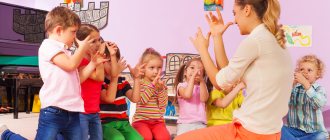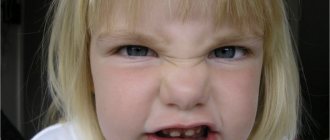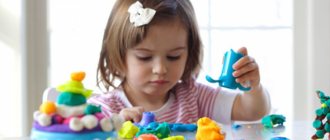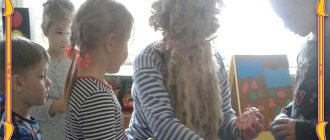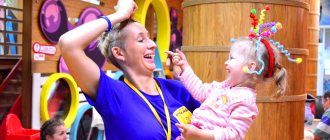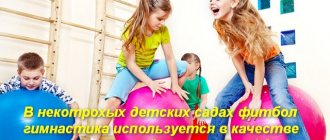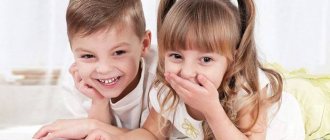Features of the development of cognitive activity of preschool children
Bibliographic description:
Shtepina, I. S. Features of the development of cognitive activity of preschoolers / I. S. Shtepina.
— Text: immediate // Current tasks of pedagogy: materials of the I International. scientific conf. (Chita, December 2011). - Chita: Young Scientist Publishing House, 2011. - pp. 89-91. — URL: https://moluch.ru/conf/ped/archive/20/1322/ (access date: 02/05/2022). Preschool childhood is a long period that lays the foundation for a future personality and largely determines it. This is a period when both the family and society create for the child all the necessary and possible conditions for their development.
It is preschool childhood that is the period of initial knowledge of the surrounding reality. In modern developmental and educational psychology, the mental development of a child is understood as the process and result of the appropriation of the cultural and historical experience of previous generations. A necessary condition for appropriating this experience is the child’s activity, including cognitive activity, manifested in appropriate activities.
The problem of forming the cognitive activity of preschool children has occupied one of the most important places in psychological and pedagogical research for decades. The solution to this problem is especially relevant in the context of developing readiness for schooling in preschool children. Research indicates a significant decrease (in comparison with the norm) in the cognitive activity of children on the threshold of schooling. Children have an insufficiently developed need for independent knowledge of the surrounding reality and a stable cognitive attitude towards the world.
The cognitive activity of preschool children should be understood as the activity manifested in the process of cognition. It is expressed in an interested acceptance of information, in the desire to clarify and deepen one’s knowledge, in an independent search for answers to questions of interest, in the manifestation of elements of creativity, in the ability to assimilate a method of cognition and apply it to other material.
It has been proven that children of preschool age, especially older preschool children, are capable of such mental operations as analysis and synthesis. Based on this ability, an appropriate teaching method can be applied.
Let's imagine that children are looking at a picture that shows a builder with a construction tool against the background of a house being built. The teacher asks to name the signs by which the children determined the person’s profession. Such an elementary analysis is a necessary starting point for a more complex, causal analysis, which allows us to consider the causal connections and dependencies between the features identified in the elementary analysis. The synthesis corresponding to such an analysis helps the child understand significant, meaningful connections and relationships.
So, continuing to consider the above picture, the teacher invites the children to think about why the builder needs the trowel he holds in his hand, why the crane is so high, why it is necessary to build such a large house, who can be pleased with the work of the builder, etc. Thinking about these questions, children begin to delve into the essence of phenomena, learn to identify internal relationships, as if they see what is not depicted in the picture, and learn to draw independent conclusions.
The lesson includes tasks for comparison by contrast and similarity. Children can compare humans and animals (how they are similar, how they are different), art, everyday life, games, food of different peoples of the world, actions, manifestations of feelings, etc. In all cases, comparison helps the formation of specific, vivid ideas; the process of forming an evaluative attitude towards oneself and others, towards events and phenomena of the social world becomes more effective and conscious [2, p.138].
When using this important methodological technique, the teacher in each specific case must decide with which comparison to start - with a comparison by similarity or by contrast. As psychologists prove, comparison by contrast is easier for children than comparison by similarity. The child quickly finds the answer to the questions: “What is the difference between an elephant and a wolf?”, but it is much more difficult for him to find similarities between them.
The technique of comparison that children have mastered helps them complete grouping and classification tasks. In order to group and classify objects and phenomena, it is necessary to be able to analyze, generalize, and highlight essential features - all this contributes to the conscious assimilation of the material and interest in it.
You should start with simple tasks: “Distribute the pictures into two groups - in one, select everything that a cook needs for his work, and in the other, a doctor.” Children 4-5 years old can easily cope with this task.
The complication of tasks goes along the line of increasing the number of objects for grouping and along the line of complication of the basis for classification. For example, preschoolers are offered different objects or their images in pictures: a winter hat, a Panama hat, a toothbrush, a ball, skis, pencils. Assignment: select items that a girl will need in winter, a boy - in summer. Explain the solution. And now, from these same items, choose those that are needed for the game, in order to be healthy, in order to talk about yourself [2, p.174].
It should be noted that the method of classification is more conducive to cognitive activity if it is not an end in itself, but is subordinated to some task that is close and understandable to the child: to select objects for a thematic exhibition, pictures for an album, attributes for a certain game, activity, etc. etc.
The manifestation of independence, elements of creativity, and invention are facilitated by such activities as modeling and design.
Modeling is absolutely essential when introducing children to the social world. The guys need to be taught how to make a plan chart. This could be a plan map of a street, a road to a kindergarten, or a site for a kindergarten. Children learn to place objects in space, correlate them, and “read” a map. Tasks like “LET’S MAKE A ROUTE FOR THE UPCOMING EXCURSION” are useful here. In modeling and designing space, you can use small building materials, paper crafts, toys or substitute items.
The method of modeling and construction develops thinking, imagination and prepares the child to perceive the world map. An increase in cognitive activity is facilitated by the combination of verbal explanation, practical implementation and gaming motivation in this method.
For example, at the beginning of the school year, children, together with the teacher, are busy setting up a group,” you need to determine a place for a play corner, for books, for plants and animals.
The teacher invites the children to first make a model of object placement out of a small builder and justify their proposals [2, p. 202].
In everyday life, children ask adults a lot of questions. These questions are developed according to theme, depth, motives, and from them one can judge the direction of the child’s interests. The thought may arise that children do not need to be specially taught to ask questions; they are already inquisitive. However, unfortunately, during the lessons themselves or about their content, children, as a rule, do not ask questions to the teacher.
In the prevailing stereotypes, during the lesson the teacher asks questions, and the child only answers them.
In this case, the teacher works without feedback, he does not immerse his students in a situation of active mental activity, free expressions of children are regarded as disciplinary violations, and, naturally, they will soon lose interest in classes. The focus on “regulated activity” fetters the children’s thoughts and puts them in the position of performers, rather than active participants in the issues discussed in class. Such underestimation of the thinking capabilities of preschoolers and fear of violation of discipline negatively affects the development of their interests and curiosity.
The ability to ask questions is necessary for both children and the teacher himself. First of all, you should think about how and what questions he poses to the children in conversations with them about what they have read, watched, and observed. It is easy to notice that the conversations are dominated by questions of a reproductive rather than problematic nature. The teacher requires the child to repeat what he has just heard, and not to think or reason.
Often such questions simply do not make sense, since the answer to them is too simple for those involved.
For example, children in the older group are shown a picture with domestic animals depicted on it. In this case, cats and kittens. The traditional question “Who is depicted in the picture?” appropriate for younger children, but completely useless for older children who are interested in problematic, causal questions. This refers to questions such as: “Why do kittens frolic, but an adult cat does not?” or “What can you call this picture in one word?” [2, p.50].
If the teacher learns to correctly formulate his questions, then it will become clearer to him how to teach children to ask questions to an adult. You can stimulate children's curiosity with a direct sentence: “Do you want to know anything else about the North Pole? Then ask, and I will try to answer you.”
It is useful to positively evaluate the very fact of posing the question or its successful formulation.
At the end of the lesson, you can specifically leave two or three minutes so that the children can ask their questions. If the teacher does this systematically, the children get used to this form of work and are ready to ask and ask. The teacher’s task is to quickly and intelligently respond to questions: answer some immediately (especially if they relate to today’s lesson), for others - say that this is the topic of the next lesson and the children will receive the answer later, for others - invite someone to answer from the guys or look for the answer in the illustrations of the book, and then together talk about what you learned.
Getting used to independently searching for answers to your questions is absolutely necessary, especially for future schoolchildren, but here the teacher is required to have tact and a sense of proportion so as not to extinguish the children’s desire to ask questions to adults.
The most important didactic principle, without the use of which it is impossible to talk about the strength of knowledge acquisition and the cultivation of feelings, is repetition. In a specific lesson, it can serve as a leading method or methodological technique. The forms of organization of repetition are different. Direct Repetition—Children are required to be able to repeat what they have learned. It occurs at the level of reproduction in the form and in the same formulations that were given during the initial perception of the material. Examples include looking at the same painting again, memorizing a poem, re-reading a work of art, or asking reproductive questions in a conversation. Such repetition is possible and useful at the end of classes, when you need to consolidate the knowledge you have just acquired. The element of direct repetition can also become a supporting, starting point in the transition to new knowledge. This type of repetition does not imply a creative attitude towards the material being learned.
Another thing is the application of knowledge in a similar situation. This form of repetition is based on associative connections that arise during the perception of new material, new objects, objects. “What does this object look like?”, “What Russian fairy tale does the Ukrainian fairy tale “Rukavichka” remind you of?” Or: “In the last lesson we talked about musical instruments played by people from different countries. What people does this musical instrument belong to?” Such questions force children to remember what they already know and relate this knowledge to new ones.
It happens that a child returns to already acquired knowledge in a new situation, when it is necessary to rely not on specific examples, but on previously formed generalizations.
For example, in the previous lesson, children learned that vision in humans and in different animals has its own characteristics. Now the teacher offers to solve a logical problem, based on existing knowledge: “Who can see best in the dark; see something from a very high altitude; read an interesting story in a book?” This is the so-called repetition at the indirect level.
One source of development of cognitive activity of older preschoolers, as V.V. rightly proves in their studies. Davydov and N.E. Veraksa, represents the creative principle in the personality of a creative person. Creativity is considered as a human activity that creates new material and spiritual wealth that has social significance, where novelty and social significance are the main criteria of creativity [1, p.287]. Literature:
- Veraksa N.E. Personality and culture: a structural-dialectical approach [Text] / N.E. Veraksa // “Changes”. Pedagogical magazine. -2000. -No. 1. -WITH. 21-39.
- Motivational preferences of various forms of cognitive activity of older preschoolers // Journal of Applied Psychology. – 2003. – No. 2. – 234 p.
Key terms
(automatically generated)
: child, teacher, activity, cognitive activity of children, subject, kindergarten, preschool childhood, preschool age, methodological technique, social significance.
Neoplasms of early age
The development of active cognitive activity in children of early and early preschool age is marked by the following changes occurring in the structure of the child’s personality.
- Formation and development of self-awareness . The child begins to gradually separate himself from the world around him. He develops such qualities as independence, curiosity, and interest in the world around him. He is interested in everything that happens around him and what surrounds him in particular.
- Basic trust in the world around you . It develops in the process of the child’s interaction with people around him and the acquisition of his first positive experience.
- Determination . The child learns to direct his activities and structure them to achieve his own goals. Children form an understanding of what specific actions need to be performed to obtain a particular result and make their first attempts to follow one or another instruction. Purposefulness gives the child the opportunity to understand the meaning of cognitive activity and complete what he starts. By the beginning of preschool age, this quality must be formed.
- Creative activity . Gaining experience in interacting with the world around him, the child begins to gradually transform it, manipulating and experimenting with its content. Therefore, it is important to encourage his participation in creative activities in any form.
Features of development of young children
